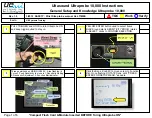
Concepts and Features
R&S
®
ZNC
30
User Manual 1173.9557.02 ─ 13
The settings correspond to the most common functions in the "TRACE > MARKER >
Markers", "TRACE > MARKER > Marker Properties", and "TRACE > MARKER > Marker
Search" menus.
Marker Coupling
The concept of marker coupling means that corresponding markers on different traces
(i.e. markers with the same number or reference markers) are positioned to the same
stimulus values but keep their independent format and type settings.
When a trace with markers is selected as the active trace and marker coupling is switched
on, the following happens:
●
The active trace and all associated markers are left unchanged. The active trace
markers become the master markers of the recall set.
●
Markers on the other traces which have no corresponding master marker are
removed but remember their properties and can be re-activated after the coupling is
released.
●
The remaining markers on the other traces become slave markers and are moved to
the position of the corresponding master markers. "Missing" slave markers are cre-
ated so that each trace has the same number of markers placed at the same position.
●
If the position of a master marker is outside the sweep range of the slave trace, the
slave marker is displayed at the edge of the diagram. The marker info field indicates
an invalid measurement result:
While marker coupling is active, it is possible to:
●
Move a master marker and thus change the position of all corresponding slave mark-
ers.
●
Activate another trace in order to make the associated markers the new master
markers.
Marker coupling makes sense only if the master and the slave traces use the same stim-
ulus variable. Channels with a different stimulus variable (sweep type) are not coupled.
Marker Search Functions
The search functions are tools for searching measurement data according to specific
criteria. A search consists of analyzing the measurement points of the current trace (or
Screen Elements
















































